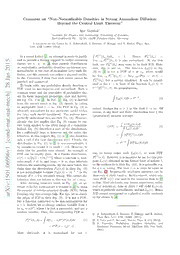
Comment on "Non-Normalizable Densities in Strong Anomalous Diffusion: Beyond the Central Limit Theorem" PDF
Preview Comment on "Non-Normalizable Densities in Strong Anomalous Diffusion: Beyond the Central Limit Theorem"
Comment on “Non-Normalizable Densities in Strong Anomalous Diffusion: Beyond the Central Limit Theorem” Igor Goychuk1 1Institute for Physics and Astronomy, University of Potsdam, Karl-Liebknecht-Str. 24/25, 14476 Potsdam-Golm, Germany A comment on the Letter by A. Rebenshtok, S. Denisov, P. H¨anggi, and E. Barkai, Phys. Rev. Lett. 112, 110601 (2014). Ina recentLetter [1], anattempt is madeto justify Pv(α)(v¯α,t)dv¯α = 1. Hence, P∞(α)(v¯α) := 5 and to provide a further support to earlier erroneous lRimt→∞Pv(α)(v¯α,t) is also normalized. At the first 01 claims, see e. g. in [2], that particle distributions look, our P∞(α)(v¯α) may seem to be their ICD. How- or,equivalently,probabilitydensitiescanbecomenon- ever, this is not so. The function I (v¯) in Eq. 2 cd normalizable in the case of anomalous L´evy walk dif- (9) in [1] is not a PDF of v¯ ≡ v¯1, which would n fusion,andthis anomalycanreflectaphysicalreality. (1) a be limt→∞Pv (v¯1,t) = limt→∞tP(x = v¯t,t) = In this Comment, I show that such claims cannot be J justified and supported. P∞(1)(v¯1), but a special construct. It can be consid- 8 ered as the t → ∞ limit of the function I (v¯,t) := To begin with, any probability density function or cd 2 PDF must be non-negative and normalized. Both a tα−1Pv(1)(v¯1,t). Its normalization, ] common sense and the postulates of probability the- h ory fix these important properties, once and forever, c I (v¯,t)dv¯=tα−1, (2) e see e.g. Ch. 2 in [3]. In Ref. [1], Eq. (8) is derived Z cd m from the correct result in Eq. (2) therein by taking - an asymptotic limit t → ∞. The PDF in Eq. (2) is indeed diverges for α > 1 in the limit t → ∞. Of t a obviously normalized for any particular model within course, at any fixed and finite observation time t, the t the L´evy walk model considered. The authors seem s (generalized) moment averages . perfectly understandthis,seetheir Eq. (3). However, t a already this fact implies that Eq. (8) cannot be cor- m rect being applied to the whole range of x variations. h|v¯|qi = |v¯|qIcd(v¯,t)dv¯ (3) - Indeed, Eq. (8) describes a part of the distribution, R Icd(v¯,t)dv¯ d for a sufficiently large x, however, not the entire dis- R n = |v¯|qP(1)(v¯,t)dv¯ o tribution. Inthis respect,Eq. (1)in[1]alsodescribes Z v c only a tail of the time distribution ψ(τ). Clearly, the [ distribution in Eq. (1) in [1] is non-normalizable, if = t1−αZ |v¯|qIcd(v¯,t)dv¯ 1 by mistake to extend it to small τ → 0. However, to v claim this for possible were absurd. An example of 6 PDF can be readily given. It is Pareto distribution, can be found either with Icd(v¯,t), or with PDF 99 ψ(τ)=α/[τ0(1+τ/τ0)1+α],whereaconstantτ0 sepa- Pv(1)(v¯,t). However,it is incorrectto use for this pur- 6 rates small, τ ≪τ0, and large, τ ≫τ0, time intervals pose Icd(v¯) obtained in the formal limit of infinite t, 0 betweenthescatteringevents. Bythesametoken,the astheauthorsdointheirEq. (13). Itisgenerally,e.g. . claim that the distribution P (x,t) in their Eq. (8) for q <α, wrong. The limit t→∞ must be taken in 1 A is not normalizablebecause P (x,t)∼|x|−1−α in the our Eq. (3). Importantly, stochastic numerics can be 0 A 5 vicinity of x→0 is obviouslywrong. The correctdis- doneonlyatfinite tandτ0. Inthisrespect,whichcon- 1 tribution does not behave in this way for |x|<v τ . crete PDF ψ(τ) was used in the numerics done in [1] 0 0 v: After deriving incorrect result in Eq. (8), an at- isdim. Mostobviously,anydecentexperiment,either i tempttofurthersubstantiateitismadein[1]byusing real or numerical, done at finite t will yield Icd(v¯,t), X the conceptofinfinite covariantdensity(ICD). Below whichisperfectlynormalizable,andnotIcd(v¯). Hence r Iexplainwhythisattemptfails. Forthis,letusclarify ICD cannot correspondto a physicalreality,contrary a the origin of ICD in their Eq. (9). It is not a PDF, to the claims in [1]. but a function concocted to be non-normalizable for α >1. Indeed, let us change random variable from x to v¯ = x/tα, where t is just a parameter, and not a α random variable. Then, the corresponding PDF is [1] A. Rebenshtok, S. Denisov, P. H¨anggi, and E. Barkai, Phys. Rev.Lett. 112, 110601 (2014). Pv(α)(v¯α,t)=Z δ(v¯α−x/tα)P(x,t)dx (1) [2] E. Lutz and F. Renzoni, NaturePhys. 9, 615 (2013). [3] A. Papoulis, Probability, Random Variables, and =tαP(x=v¯αtα,t). Stochastic Processes, 3d ed. (McGraw-Hill, New York, 1991). Most obviously, it is normalized for any t,
